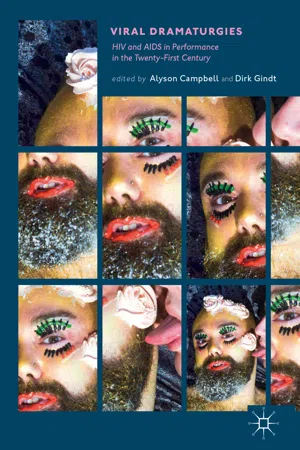This incident, recounted by performers and sex worker activists Elena Jeffreys and Janelle Fawkes in their contribution to this volume, crystallises in a potent image the extent to which HIV treatment in the twenty-first century has been, and continues to be, divided along national, racial, gendered, class, economic, geo-political and sexual identity lines. The single pill in its little gift box offered a promise of medical relief—provided there were the financial and cultural resources to have access to it on a regular basis. The example shows, furthermore, how the dominant HIV and AIDS discourse is in the hand of scientists and, above all, transnational pharmaceutical corporations. This spectacular performance of so-called benevolence—a euphemism for a shrewd marketing strategy—by a pharmaceutical company at the fifteenth International AIDS Conference is an example of ‘the HIV industrial complex’ at work: that is, ‘the ways in which governments, NGOs, Big Pharma , medical researchers, and funders have formed a global bureaucratic matrix … that promotes eradicating HIV and AIDS through programmatic (economic, biomedical , technological, and pharmacological) interventions’ (Guta et al. 2011: 15). The downside of what Adrian Guta, Stuart J. Murray and Alex McClelland theorise as a hyper-rational and scientifically framed approach is that it ‘privileges particular ways of knowing and renders dissent and activism a threat to this rationality’ (ibid.: 15). Non-rational behaviours and actions—diverse activist and grass-roots responses that open up counternarratives to this hegemonic HIV and AIDS discourse, including, we might point out, performance—sit outside this pragmatic frame and risk being pushed to the margins.1In 2004, on the final day of the Bangkok AIDS Conference, a drug company packaged thousands of single antiretroviral pills into jewellery boxes and allowed one pill per delegate to be collected from their corporate booth. Many delegates at the conference came from countries where access to treatment medication was, and continues to be, restricted to the rich. There was a degree of confusion among sex worker activists who attended and whose background or migration status excluded them from accessing life-saving HIV treatment. After an entire week of protests, workshops, presentations, posters, activism, performance, installation, media and the experience of generally being marginalised within the broader HIV sector, we [sex worker activists] witnessed many migrant sex workers living with HIV and without access to treatment carrying their single pill away from the corporate booth.(Jeffreys and Fawkes , this volume, Chap. 3)

Viral Dramaturgies
HIV and AIDS in Performance in the Twenty-First Century
- English
- ePUB (mobile friendly)
- Available on iOS & Android
Viral Dramaturgies
HIV and AIDS in Performance in the Twenty-First Century
About This Book
This book analyses the impact of HIV and AIDS on performance in the twenty-first century from an international perspective.It marks a necessary reaffirmation of the productive power of performance to respond to a public and political health crisis and act as a mode of resistance to cultural amnesia, discrimination and stigmatisation. Itsets out a number of challenges and contexts for HIV and AIDS performance in the twenty-first century, including: the financial interests of the pharmaceutical industry; the unequal access to treatment and prevention technologies in the Global North and Global South; the problematic division between dominant (white, gay, urban, cis-male) and marginalised narratives of HIV; the tension between a damaging cultural amnesia and a potentially equally damaging partner 'AIDS nostalgia'; the criminalisation of HIV non-disclosure; and, sustaining and sustained by all of these, the ongoing stigmatisation of people living with HIV.
This collection presents work from a vast range of contexts, grouped around four main areas: women's voices and experiences; generations, memories and temporalities; inter/national narratives; and artistic and personal reflections and interventions.
Frequently asked questions
Information
1. Viral Dramaturgies: HIV and AIDS in Performance in the Twenty-First Century
Keywords
PerformanceDramaturgiesAffectAIDS activismStigmaTruvadaCriminalisationNostalgiaTable of contents
- Cover
- Front Matter
- Section 1. Introduction
- Section 2. Women’s Voices and Experiences
- Section 3. Generations, Memories and Temporalities
- Section 4. Inter/national Narratives
- Section 5. Artistic and Personal Reflections and Interventions
- Section 6. Coda
- Back Matter